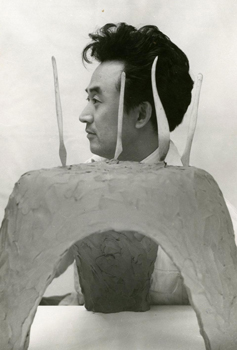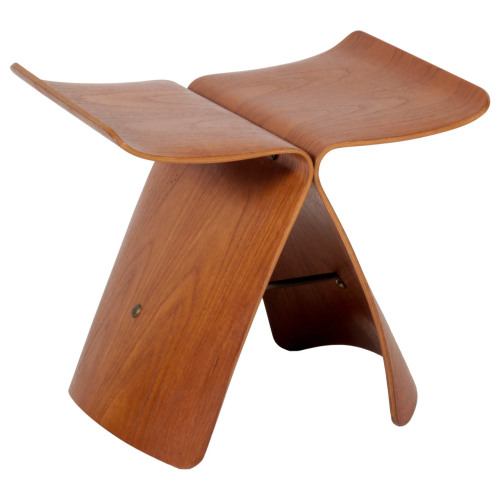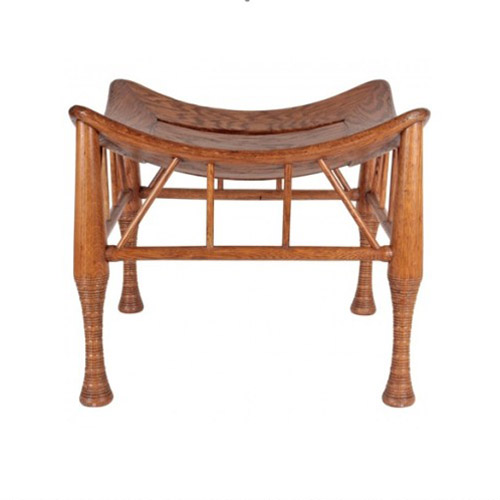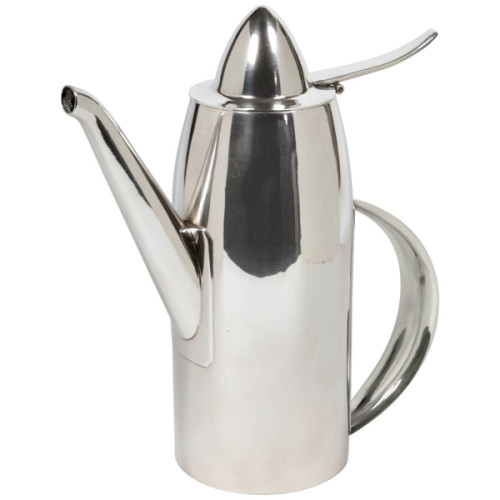

Sori Yanagi / Tendo Co. Ltd. / Japanese Crafts “Butterfly” Stool c.1956
Sori Yanagi (1915-2012), Japan
Tendo Co. Ltd., Japan
Butterfly stool, 1956.
Bleached rosewood veneer on plywood with brass.
H: 15” x W: 16 ½” x D: 12”
Price: $4,900
This model can be found in the collections of the Museum of Modern Art and the Metropolitan Museum in New York.
The Japanese designer Sori Yanagi is best known for his 1956 Butterfly Stool. It is both elegant and utterly simple: two curved pieces of molded plywood are held together through compression and tension by a single brass rod. The stool’s graceful shape recalls a butterfly’s wings, and has also been compared to the form of torii, the traditional Shinto shrine gates. He loved traditional Japanese crafts and was dedicated to the modernist principles of simplicity, practicality and tactility that are associated with Alvar Aalto, Charles and Ray Eames, and Le Corbusier.”
Yanagi, who studied architecture and art at Tokyo’s Academy of Fine Art, was inspired by the work of Le Corbusier and by the designer Charlotte Perriand, with whom he worked in the early 1940s, while she was in Tokyo as the arts and crafts adviser to the Japanese Board of Trade. But perhaps the most indelible influence on Yanagi was that of his father, Soetsu Yanagi, who led the “mingei” movement, which celebrated Japanese folk craft and the beauty of everyday objects, and who founded the Nihon Mingeikan (or Japanese Folk Crafts Museum) in Tokyo. Yanagi fils, who was named director of the museum in 1977, succinctly described his design aesthetic in a 2002 interview in The Japan Times: “I try to create things that we human beings feel are useful in our daily lives. During the process, beauty is born naturally.” Throughout his life, Sori Yanagi was inspired by what he called “anonymous design” — he cited the Jeep and a baseball glove as two examples — and he in turn inspired younger designers, like Naoto Fukasawa, Tom Dixon and Jasper Morrison.
Related Products
-
Liberty & Co. / Leonard Wyburd Egyptian Revival Four-Legged Oak Thebes Stool c. 1890-1895
Leonard Wyburd UK
Liberty & Company LondonFour-legged Thebes stool circa 1890-95. Oak with highly figured grain, concave slat seat, turned details.
Marks: 4 (impressed on underside)
This design was registered by Liberty & Co. in 1884.
Related Liberty & Co. stools illustrated: Liberty’s 1875-1975 : An Exhibition to Mark the Firm’s Centenary (London: Victoria & Albert Museum, 1975) p. 35, illustr. C1, Liberty Design, 1874-1914 , Barbara Morris (London: Octopus Publishing Group:, 1989) p. 103; Egyptomania: Egypt in Western Art, 1730-1930 (Paris: Éditions de la Réunion des Musées Nationaux and Ottawa: National Gallery of Canada, 1994), pp. 465-66.
H: 15″ x D: 17″ x W: 17″
One of the driving influences of the Aesthetic Movement of the late 19th century was an informed interest in authentic ancient designs inspired by recent archaeological discoveries. Both the three and four-legged Thebes stool were inspired by actual furniture and wall paintings unearthed from royal tombs in the ancient Egyptian city for which they are named. Leonard Wyburd, who was one of the principal designers for Liberty, patented his designs for the Thebes stools in 1884. Liberty & Co. continued to make the popular stools into the early 1900’s.
-
Archibald Knox (attr.) / Barnard & Sons Sterling Coffee pot 1903
ARCHIBALD
EDWARD BARNARD & SONS London, UK
Coffee pot 1903
Sterling silver
Marks: B WMJS RD into a shield (Barnard & Sons), hallmarks, “h” (London Silver hall mark for 1903), 419 (on bottom of pot)
H: 8 3/4″
Price: $19,500









